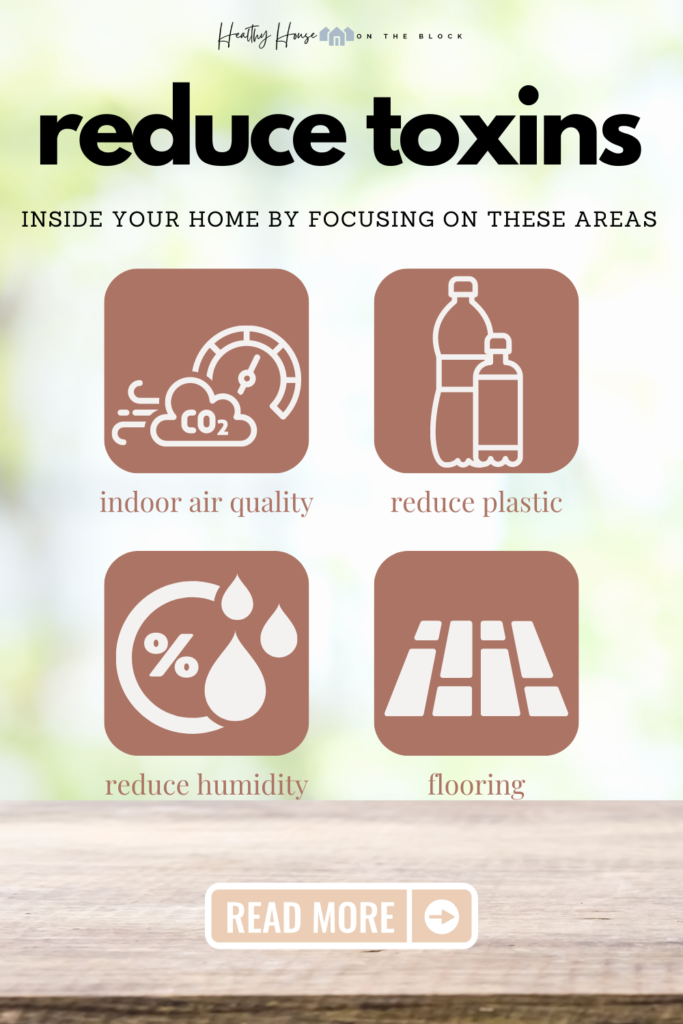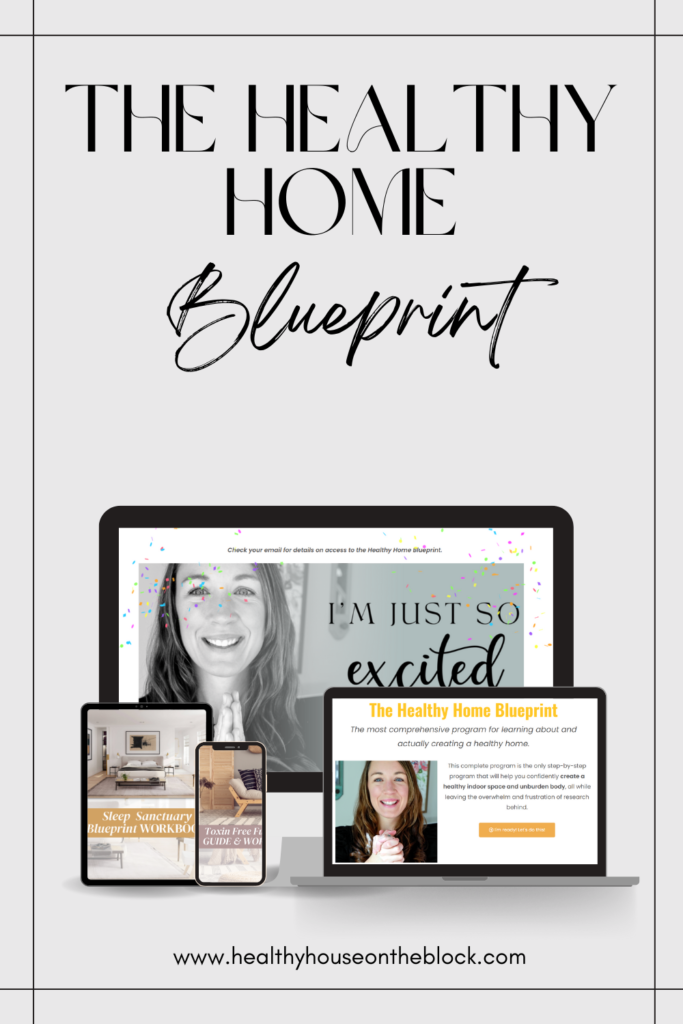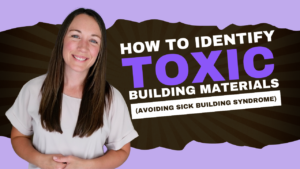
Sometimes I get asked to give guidance on how to go completely toxin free and remove all toxins and plastics from inside a healthy home. And the truth is, there is really no such thing. I’m a firm believer in moderation — from enjoying a glass or wine to having unproductive days of play.
I really think that because of the world we live in, where toxins are inevitable, if we live with this notion that we have to get rid of every single toxin, we’ll stress ourselves out and become frustrated with the fact that there are toxins around us.
The beauty in all of this, is that we get to choose which ones we want to eliminate or limit in our homes. There are areas we have complete control over (like getting rid of fragrance, choosing our cleaning supplies, and so on. And these are the areas where maybe we can eliminate the most toxins.
But there are also toxins that we really don’t have control over and we need to just let them be rather than stress out about them. The biggest takeaway here is that stress and financial stress over trying to change things that just aren’t in our complete control is toxic to our bodies.

SOME PLASTICS & TOXINS ARE NECESSARY (AND LIFE SAVING)
One thing that is so important to understand is that some toxins are not only necessary, but life saving. It’s also important to know that some toxins are actually naturally occurring within the world and the earth. In fact mold is one of those naturally occurring toxins. And while we don’t want it inside our home, impacting our health, it’s a necessary toxin that is outdoors as part of nature.
In order to create a healthy home, many of us try to reduce plastic wherever we can. In fact, I myself try to reduce the amount of plastic inside when it comes to toys (wow can this feel impossible), kitchen items and packaging. But, there are some instances where plastic is necessary and life saving.
One of my favorite examples of this is car seats and helmets (from biking to skiing and all helmets in between). Not only does the plastic contain phthalates, bisphenols and other toxins, but likely the styrofoam supports inside these items are also toxic. But without these two components, helmets and car seats just wouldn’t be as safe. Helmets and car seats are life saving in accidents and I think we can all agree that these are necessary items to use and have.
I learned this truth that some toxins are life saving when my youngest son was born. Without life saving medical intervention and tube feeding rehabilitation as a newborn, he wouldn’t be able to have a normal lifestyle. While in the moment I HATED that there were plastic tubes in and around him for his 6 months of life…in fact I worried about the impacts they could have on his health as he grew older. But it was 100% necessary and there was no safe way around having him in the NICU or fed by tubes. It literally saved his life. So many medical components are made of materials that contain polyvinyl chloride and other toxins, but they are SO necessary when you need them.

HOW TO HANDLE KNOWING TOXINS IN ARE IN YOUR HEALTHY HOME
While it can be so frustrating to know that there are toxins in your home, especially when you’re working so hard to create a healthy environment, it’s important to be able to let go of the things you can’t change. But with a few mindset shifts, you can quite easily shift your focus to the positive aspects of a healthy home.
Mindset Shift 1: Focus only on what you have complete control over. This is probably the hardest shift, but the most important shift. Sometimes when we become super excited about creating a healthier home and environment in our house, it’s quickly deflated by the realization that not everything is within our control.
And this could be for a number of reasons, because while everything is probably changeable in your home, it all comes with a price of both money and time. And so, there are things that you probably just can’t change in your home. Whether it’s your vinyl windows, or the wall to wall carpet. Those may be something you plan to change down the road, or they may be something you choose to leave. And that’s okay. Focus on the easiest things that you have total control over instead and make whatever changes there that you can.

Mindset Shift 2: You can still have a healthy home with toxins in it. A healthy home isn’t totally free from toxins (just like I posted about a few weeks ago). It certainly isn’t an all or nothing type of thing. Instead, remember that our body is always detoxing the chemicals and toxins that we come into contact with. And so by reducing whatever toxins we can, we are allowing our body to more efficiently detox what it can without becoming burdened.
The goal is to REDUCE toxins as much as possible, not necessarily get rid of them all together, which is an unattainable goal. You have to learn to be okay with the toxins in your space that may stick around. And you have to make a conscious effort to let those things go and instead focus on the toxins you can reduce.
Mindset Shift 3: Nothing is a permanent change or situation. This has been a huge hurdle for me in many areas of my life. I have to remember that nothing is really permanent, whether positive or negative. Every phase my kids have gone through, I still have to remind myself that this isn’t a permanent phase that sticks around forever. The world and we ourselves are constantly changing and shifting. Places in your home that might contain toxins that you feel frustrated with aren’t there forever.
Instead remember that you can plan ahead and make changes down the road. You just have to be intentional about those changes and work towards your goal one step at a time.
THE BEST AREAS TO FOCUS ON WHEN REDUCING TOXINS IN YOUR HOME
Indoor Air Quality is the best spot to start in your home. And the good news is that it can be SO easy to change in your home. Essentially opening windows, running vented fans using an air purifier can drastically change your indoor air quality and improve it. It can be one of the simplest ways to reduce toxins that are in house dust as well as off gassing VOCs, formaldehyde and even radon gasses.
Humidity Levels are another very easy change to make with some simple habit adjustments, but we often forget about it or don’t even know it can help Mold and VOCs love humid environments, and so by reducing our humidity levels to a safe and healthy 35%, we can avoid these two toxins in big ways. Depending on the outdoor climate and your home, it can be so easy to adjust some of your daily habits to drastically reduce humidity levels to an ideal level.
Flooring is a change you’ll likely have to plan ahead for, but it is one of the most impactful changes you can make in a healthy home. Not only is there HUGE amounts of flooring all throughout the home, but it is a high touch area on a frequent basis. Think of how often you’re touching your flooring — it’s likely the entire time you’re home. And if you have kids this one matters even more because of their close proximity to flooring throughout the day. PLan ahead for smooth surface flooring that is free from formaldehyde, VOCs and PFTEs.
Getting rid of plastic in the kitchen is often easier than you might think, but has a HUGE impact on your health and wellness. Toxins that are coming in contact with food we eat can have negative impacts on our liver, gut and entire body. And a lot of times what it boils down to is adjusting our habits and how we store our food and the items we have accumulated over the years. Swapping out plastic containers and food storage bags can seem like a tedious project, but I promise it will be SO worth it in the long run, and once you start swapping, it’s just a matter of time before your whole kitchen is free from toxins.

THE AREAS OF A HEALTHY HOME TO LET GO OF
And then there are areas that aren’t worth worrying about or trying to change in big ways. And the main reason is that the threat they pose is lower than the amount of time and effort it will take to replace them.
Drywall: Unless you’re going to be renovating or adding new drywall, it never pays to rip out perfectly good drywall to swap it with a toxin free or low toxin option. Because drywall is painted, and likely has off-gassed for a few years, it’s not a huge health threat to you. It’s one of those areas to just let go of and if you change it in the future, then great. But if not, no worries. Look at it as a bonus change when and if it comes up.
Enclosed Insulation: Because insulation is often enclosed and not being touched, it is very low on the priority list of changes. Oftentimes there is no way you’re being exposed to insulation in your home unless you open a wall or go into your attic. Insulation that is exposed can be sealed off so it won’t be touched, and that you could change out if you really wanted to. But for the most part, insulation within your walls, while it may be toxic, poses almost no healthy concern as you’re not breathing in particles or touching it.
Appliances: While you CAN opt for lower toxin appliances in your home, all appliances will have SOME toxins. And so I never recommend removing perfectly good appliances and replacing them just to lower the toxin level. If you’re going to replace an appliance anyways, THEN I think there is benefit in researching and finding a lower toxin option. But just know that there are no completely toxin free appliances, and so while you could reduce the level of toxins, you’d never get rid of them completely.
Off-Gassed/Cured Materials: Unless you’re going to be doing a project, it isn’t advised to rip out caulking or add paint to a room to somehow reduce the toxins in your space. Likely both of these products have done the most off-gassing they will over time, and so to re-do the project using lower toxin materials and products just doesn’t make sense. However, I do think it’s important to know what building materials you should use for home projects and definitely opt for a low toxin option as you plan ahead for the future.

Even if you’ve been creating a healthy home for a while, it’s important to have these gentle reminders from time to time. Remember that using what you can and making positive changes with that is the best you can do. Stress and frustration are toxic to our bodies, so let go of the changes you can’t make right now and remember the principles we talked about.



